Transform Your Bathroom: The Ultimate Guide to Japandi Style for a Serene Oasis
Are you looking to infuse your bathroom with a unique blend of calm and comfort? Japandi style offers the perfect solution, marrying Japanese minimalism with Scandinavian coziness to create spaces that are both beautiful and incredibly practical. Imagine a bathroom that transcends its function, becoming a personal spa where the day’s stress gently fades away, and a profound sense of well-being flourishes. Japandi promises precisely this, and more.
Its enduring appeal, inherent eco-consciousness, and remarkable adaptability to any bathroom size make it an ideal choice for modern homes seeking tranquility and refined simplicity. Ready to embark on a journey to transform your bathroom into a true haven of peace? Let’s delve into the core elements of Japandi style and discover how you can effortlessly integrate this calming aesthetic into your home, from thoughtful color selections to the embrace of natural materials. Your bathroom isn’t just a room; with Japandi, it becomes an experience.
Understanding the Essence of Japandi Style
The Japandi design trend is quickly becoming a favorite in contemporary homes, celebrated for its unique ability to blend two distinct yet harmonious aesthetics into spaces that exude calm and warmth. To truly appreciate Japandi, it’s essential to understand its origins and the special characteristics that define it.
The Roots of Japandi: East Meets North
Japandi beautifully bridges the design philosophies of two seemingly disparate regions: Japan and Scandinavia. Despite their geographical distance, both cultures share a deep-seated appreciation for understated beauty, meticulous craftsmanship, and highly functional design.
Japanese Influence: Zen Simplicity and Nature
Japanese design is profoundly rooted in Zen philosophy, emphasizing harmony, balance, and a deep connection with nature. Key aspects include:
- Minimalist Spaces: A strong belief in ‘less is more,’ leading to uncluttered environments that promote mental clarity.
- Clean Lines: Preference for simple, often linear forms that create a sense of order and serenity.
- Natural Elements: Extensive use of wood, stone, and plant life to bring the peacefulness of the outdoors inside.
- Wabi-Sabi: An appreciation for imperfection, transience, and the beauty found in natural, aged materials.
These elements collectively create tranquil rooms that invite contemplation and foster a close relationship with the natural world.
Scandinavian Influence: Hygge, Functionality, and Warmth
Scandinavian design contributes its signature warmth and practicality to the Japandi blend, focusing on comfort and everyday livability. It is characterized by:
- Hygge (Coziness): A core concept emphasizing comfort, well-being, and a feeling of contentment.
- Utilitarian Design: A strong emphasis on functionality, where every object serves a purpose and enhances daily life.
- Warm Minimalism: While minimalist, Scandinavian design often incorporates softer textures, warmer wood tones, and thoughtful lighting to prevent spaces from feeling cold or sterile.
- Light and Brightness: Maximizing natural light and employing light color palettes to combat long, dark winters.
This style ensures that even uncluttered spaces feel inviting, snug, and genuinely lived-in.
Defining Principles of Japandi Style

Japandi design is guided by a set of core principles that shape the aesthetic and tactile experience of any space it influences:
1. Intentional Minimalism
Japandi spaces are characterized by their uncluttered nature. This isn’t about stark emptiness but rather a deliberate curation of items, where everything present serves a purpose or brings joy. This intentional approach to minimalism helps foster a sense of calm and clarity, making the space feel more peaceful and less overwhelming.
2. Embrace of Natural Materials
The extensive use of natural materials is a cornerstone of Japandi. Raw, unprocessed elements like light woods (oak, birch), darker woods (walnut, teak), natural stone, bamboo, ceramic, linen, and cotton are favored. These materials introduce organic textures, warmth, and a direct connection to nature, grounding the interior design.
3. Serene Neutral Color Palette
Japandi color schemes lean heavily on soft, earthy, and muted tones. Think warm whites, subtle grays, beige, cream, and gentle greens or blues, often contrasted with deeper, grounding accents like charcoal or black. These colors create a tranquil backdrop that enhances natural light and promotes a sense of serenity, reminiscent of a quiet, natural landscape.
4. Uncompromising Functionality and Craftsmanship
Every element in a Japandi room is chosen for its utility and quality. Design is not just about aesthetics; it’s about how well a space or object functions within daily life. This emphasis on functionality is paired with a deep respect for craftsmanship, favoring well-made, durable items that are built to last and age gracefully, embodying the Wabi-Sabi philosophy.
By thoughtfully integrating these principles, Japandi creates environments that are not only visually appealing but also promote a slower, more mindful way of living. It encourages you to declutter, focus on quality, and genuinely enjoy the space you inhabit.
Why Japandi is the Ideal Choice for Your Bathroom Renovation

When considering a refresh or a complete overhaul for your bathroom, Japandi style presents itself as an exceptionally fitting and rewarding choice. Here’s why this unique aesthetic is perfectly suited for creating your ultimate bathroom sanctuary:
1. Cultivating a Spa-Like Atmosphere
A Japandi bathroom effortlessly transforms into a personal mini-spa, offering a refuge where true relaxation begins. Imagine stepping into a space designed to immediately soothe your senses, washing away the day’s stresses. The calm and understated elegance create an environment conducive to unwinding and rejuvenation, turning routine into ritual.
2. Enhancing Overall Well-Being
The tranquil ambiance of a Japandi bathroom significantly contributes to improved mental and emotional well-being. Starting your day in such a peaceful setting can set a positive tone, while ending it there provides a calming transition. This thoughtful design fosters a sense of peace, clarity, and comfort that positively impacts your mood and daily outlook.
3. Embracing Timeless, Enduring Style
Japandi is far more than a fleeting trend; its foundation in classic design principles ensures its longevity. The combination of clean lines, natural materials, and a neutral palette results in an aesthetic that remains fresh and elegant for years to come. Investing in a Japandi bathroom means creating a space that will retain its beauty and relevance for the long haul, defying seasonal fads.
4. Championing Earth-Friendly Design
At its core, Japandi promotes sustainable living. It prioritizes the use of natural, durable materials and advocates for quality over excessive quantity. This approach reduces waste, minimizes environmental impact, and fosters an appreciation for responsibly sourced elements. Choosing Japandi is a conscious decision to design with respect for our planet.
5. Remarkable Suitability for Any Space
One of Japandi’s most compelling attributes is its incredible flexibility. Regardless of your bathroom’s dimensions—be it a compact powder room or a sprawling master bath—Japandi adapts with grace. Its inherent focus on simplicity, efficient use of space, and decluttering makes it supremely adaptable, enhancing the perceived size and functionality of any area.
6. Perfect Alignment with Modern Lifestyles
In an increasingly fast-paced world, many individuals seek ways to simplify their lives and create peaceful pockets within their homes. A Japandi bathroom directly supports this desire by offering a clutter-free zone dedicated to relaxation and recharging. It encourages mindful living, allowing you to disconnect from digital noise and reconnect with yourself in a serene environment.
Opting for Japandi in your bathroom signifies a commitment to creating a space that not only looks exquisite but also deeply nurtures your spirit. This style has the power to elevate your daily routines into moments of pleasant, peaceful reflection.
Key Elements for Crafting Your Japandi Bathroom
To successfully infuse your bathroom with the signature Japandi aesthetic, focus on these essential design elements:
1. The Calming Neutral Color Palette
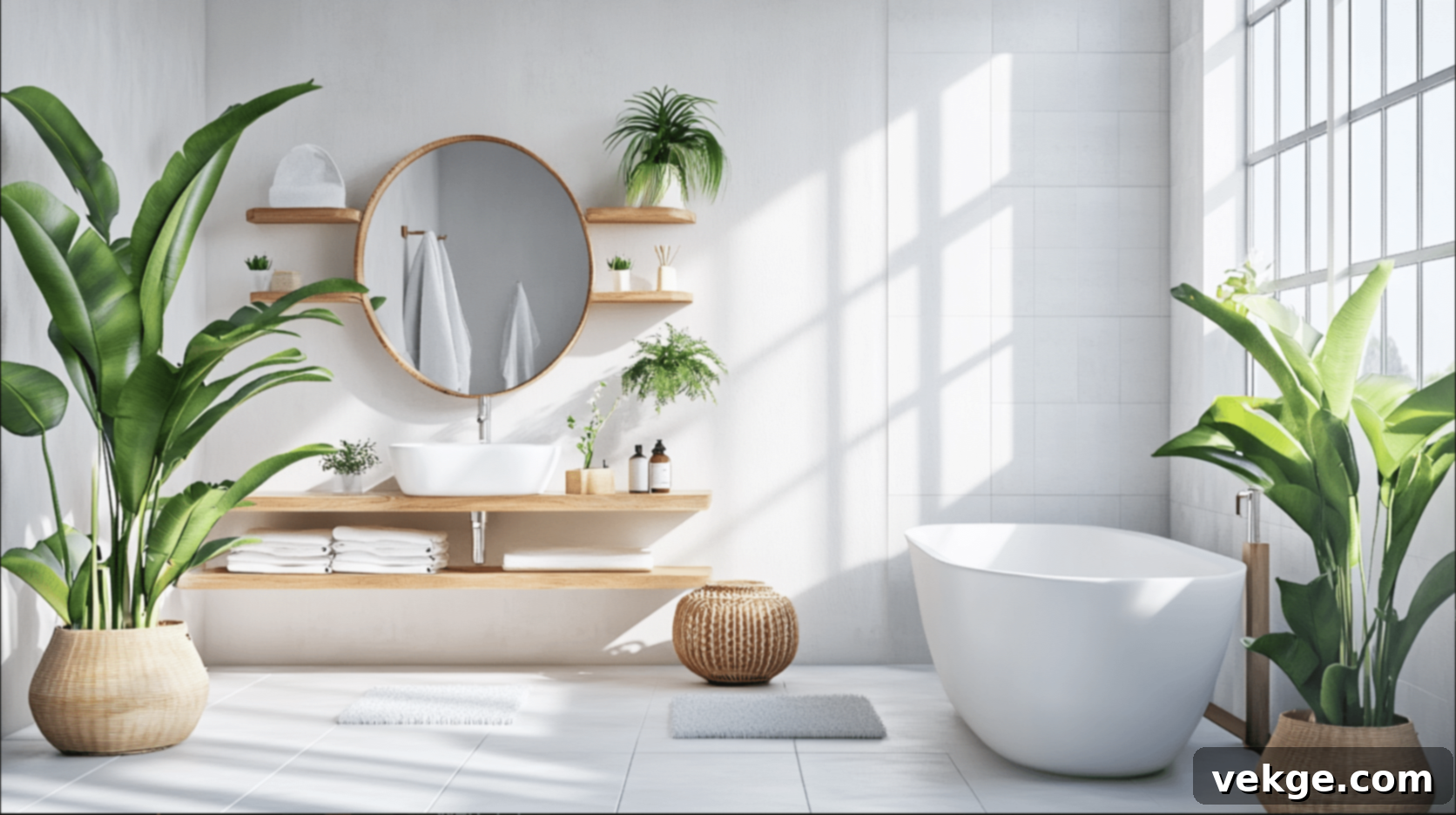
The foundation of any Japandi bathroom lies in its soft, serene color scheme. Envision a palette dominated by warm whites, creamy beiges, gentle light grays, and understated earthy tones like muted greens or clay. These colors are not merely decorative; they actively contribute to making the room feel more expansive and open, while cultivating an immediate sense of peace and tranquility.
When you enter a Japandi bathroom, the colors should instantly evoke a feeling of relaxation. Begin by painting walls in a soft, inviting white or a subtle light gray. Introduce warmth and depth by incorporating natural wood tones into your vanity, shelving, or even a statement accent wall. The goal is to create a harmonious and soothing backdrop that allows other natural elements to shine without overwhelming the senses.
2. Maximizing Natural Light
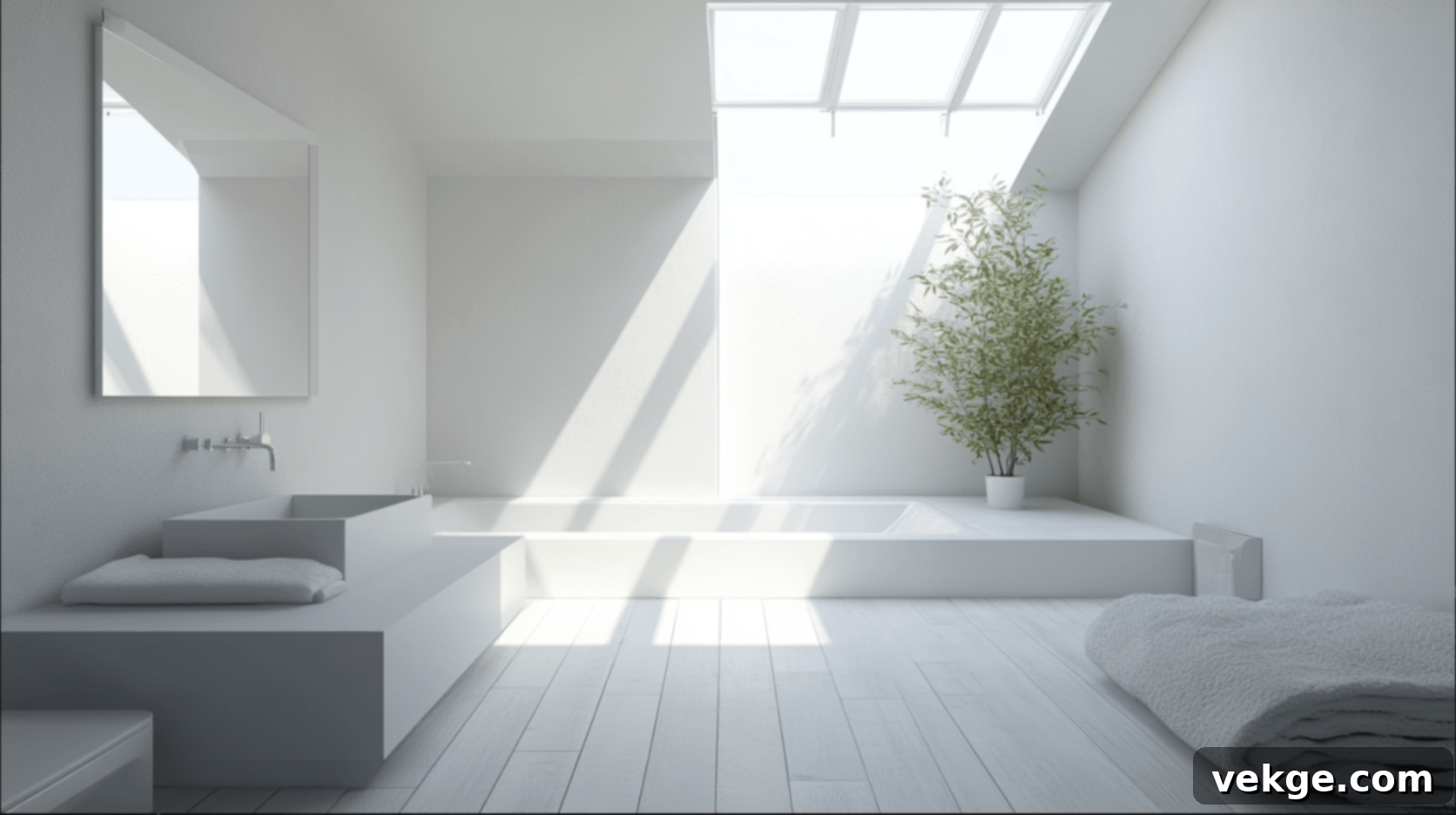
Light is a paramount element in Japandi design, acting as a vital component in creating an airy and fresh atmosphere. The primary objective is to harness and maximize natural light wherever possible. Large windows, strategically placed skylights, or even a well-chosen frosted glass block can allow sunlight to flood the room, instantly making it feel more vibrant and expansive.
If extensive natural light isn’t an option, compensate by using light-colored materials for walls, floors, and fixtures, which effectively bounce light around the room. Thoughtfully placed mirrors can also amplify brightness and create an illusion of greater space; position them opposite windows or light sources to reflect natural illumination. For artificial lighting, opt for warm, diffused light fixtures that mimic natural daylight, avoiding harsh, cold illumination.
3. Incorporating Warm Wooden Elements
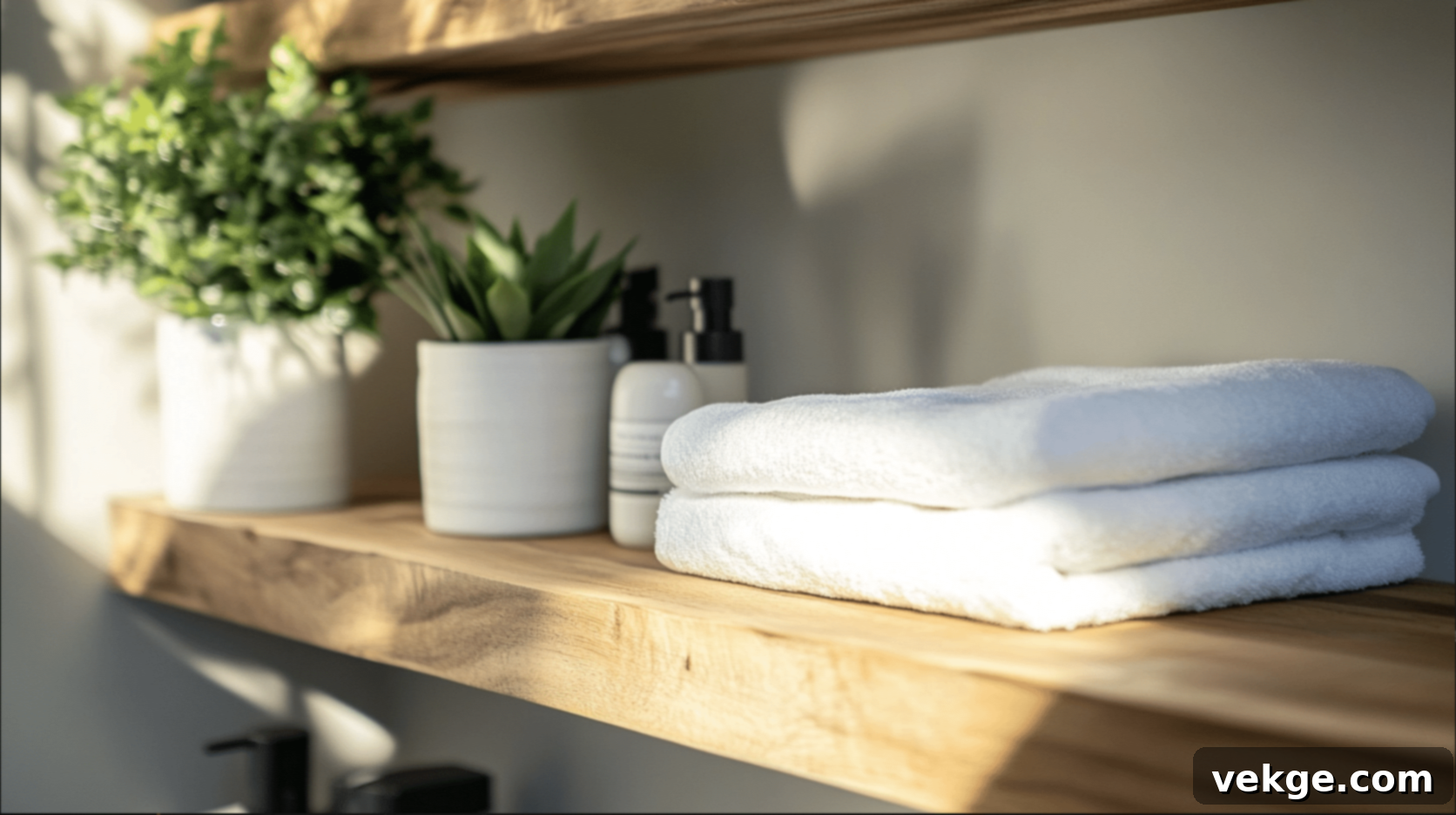
Wood is indispensable in a Japandi bathroom, infusing the space with organic warmth, texture, and a direct connection to nature. Excellent choices for bathroom environments, known for their durability and moisture resistance, include teak, oak, bamboo, and walnut. These woods can be beautifully incorporated into various elements: a sleek floating vanity, open shelving, bath caddies, or even a slatted wall feature.
The natural grain and subtle variations in wood add visual interest without creating clutter or busyness. To ensure longevity in a damp environment, always treat wooden elements with appropriate oils, sealants, or varnishes. Promptly clean any spills, and use bath mats to protect wood from standing water. With proper care, these natural wooden accents will maintain their beauty and contribute to your bathroom’s serene ambiance for years.
4. Embracing Clean Lines and Intentional Minimalism
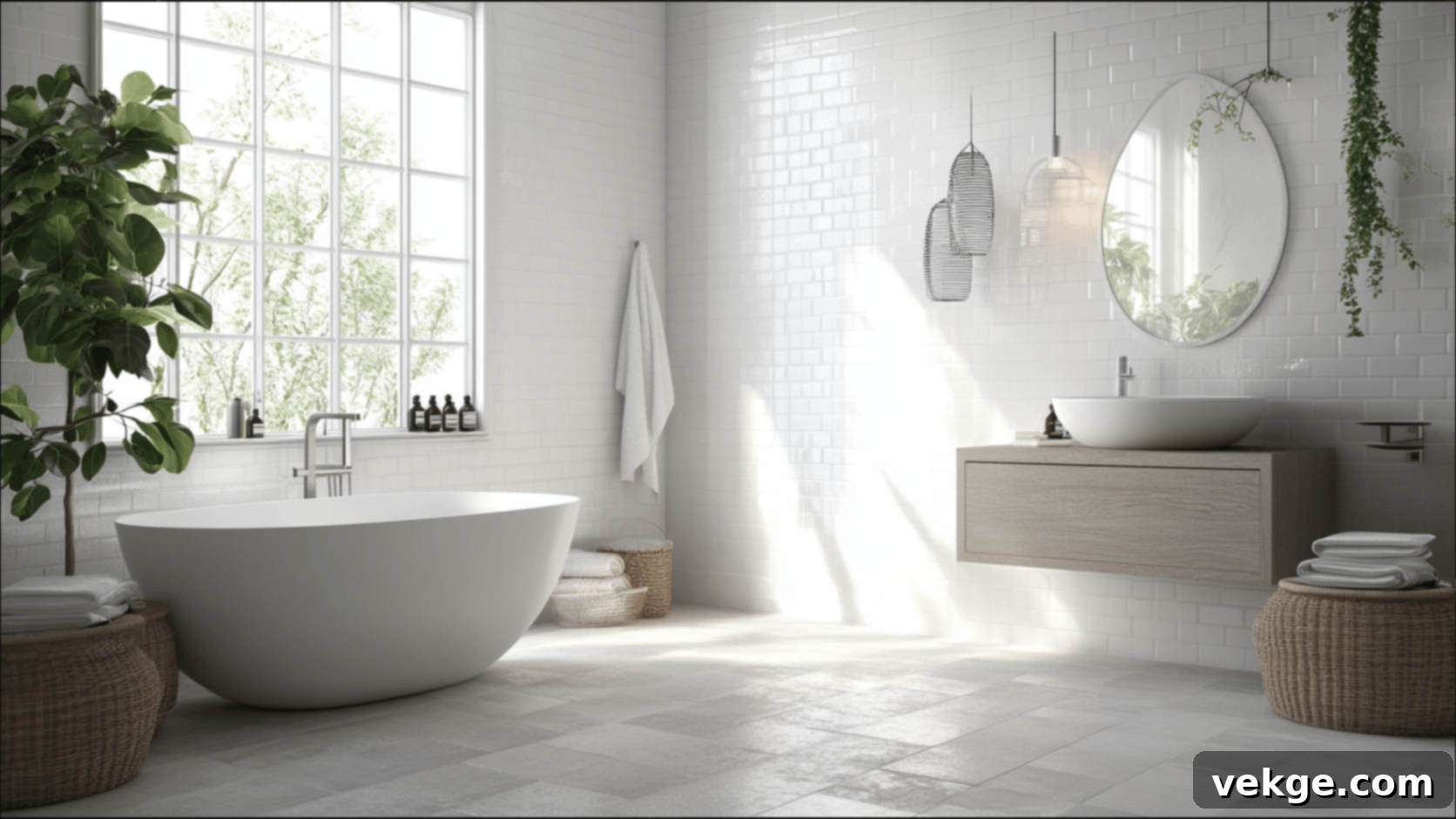
A hallmark of Japandi style is its unwavering commitment to simple, uncluttered forms and straight, refined lines. When selecting fixtures, opt for sinks, tubs, and toilets that feature smooth profiles and understated designs. Avoid overly ornate details, fancy curves, or elaborate embellishments. The beauty lies in their simplicity and functional elegance.
Maintain clear countertops by minimizing visible items. Invest in quality storage solutions like built-in cabinets or drawers to discreetly house toiletries and everyday essentials. Choose a frameless mirror or one with a slender, unadorned frame. The overarching goal is to cultivate a calm, open, and airy feel where every item has a clear purpose and a designated, often hidden, home. If something doesn’t need to be on display, tuck it away to preserve the tranquil aesthetic.
5. The Vital Touch of Plants and Greenery
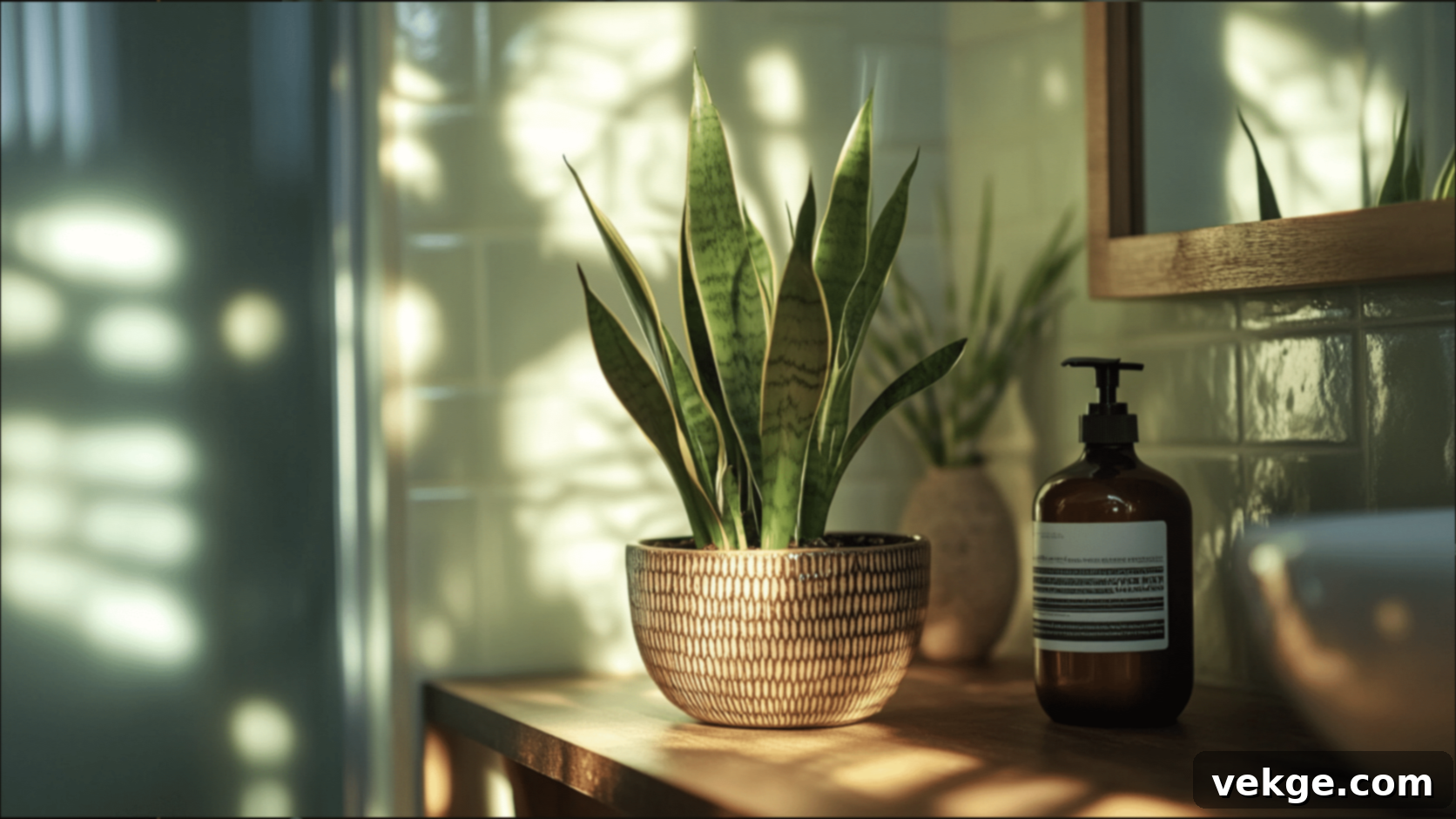
Integrating plants is crucial for bringing life, freshness, and a soft splash of natural color into a Japandi bathroom without disrupting its serene vibe. Select plants that thrive in humid environments and are relatively low maintenance. Excellent choices include snake plants, pothos, bamboo, ZZ plants, or ferns.
Place a small potted plant on a shelf, a larger one in an empty corner, or hang a delicate trailing plant. Beyond their aesthetic appeal, many plants also help purify the air, further enhancing the spa-like atmosphere. If your bathroom lacks sufficient natural light, high-quality artificial plants can offer a similar touch of nature without the need for sun or water, maintaining the desired aesthetic with ease.
6. Layering Textures and Natural Textiles
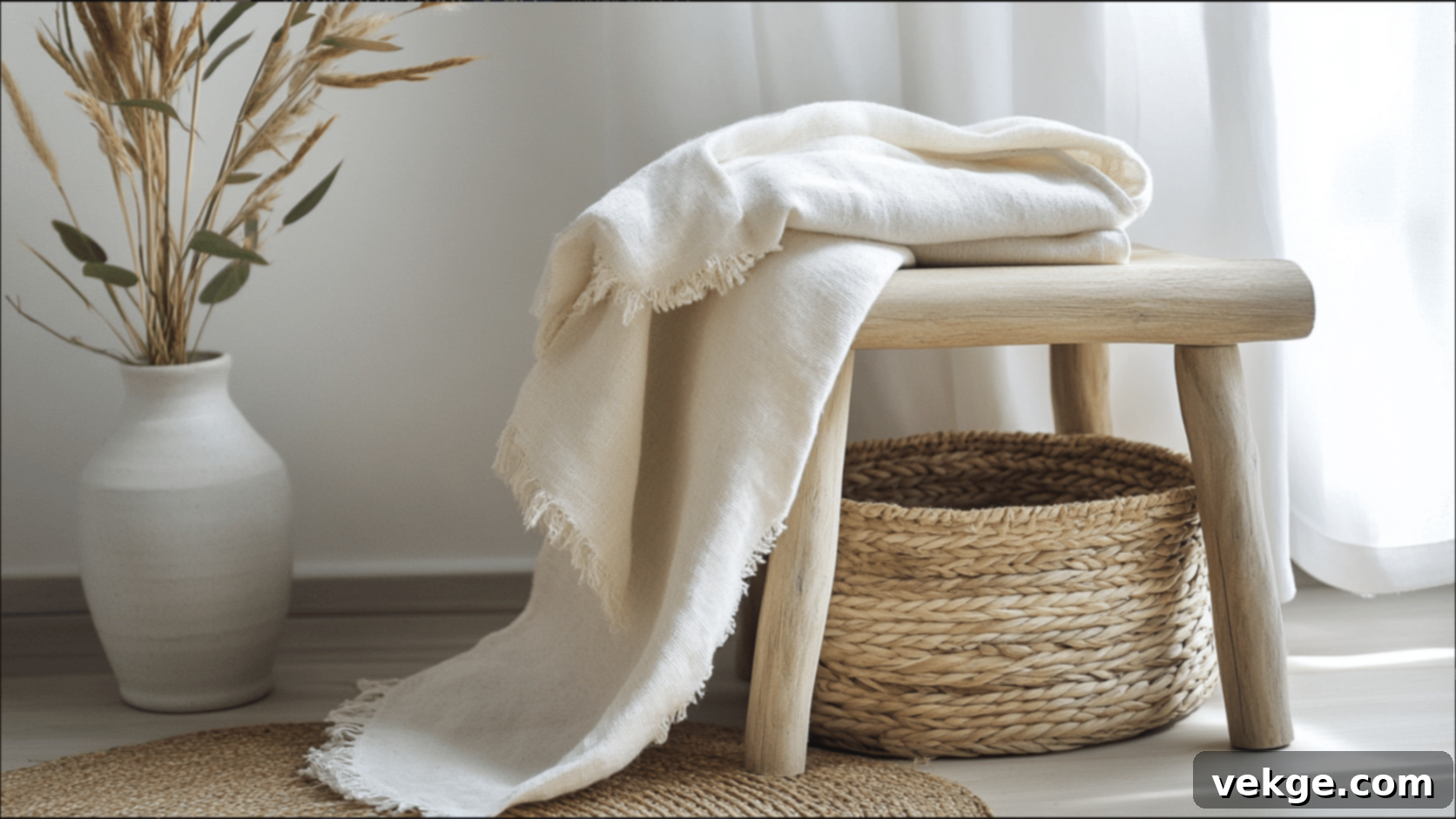
In a Japandi bathroom, texture introduces depth and interest without relying on vibrant colors or elaborate patterns. Focus on natural fibers for towels, bath mats, and shower curtains. Materials like organic cotton, linen, hemp, or waffle-weave fabrics not only feel luxurious but also align perfectly with the natural theme.
Consider adding a woven rattan basket for laundry or storage, a textured ceramic soap dispenser, or a stone bath tray. The strategy is to maintain a neutral color palette while varying the tactile qualities of different elements. This subtle interplay of textures creates a rich, inviting atmosphere that feels cozy and welcoming without ever appearing busy or cluttered. These soft textures enhance the overall sensory experience, making the bathroom a truly comforting space.
7. Thoughtful and Functional Accessories
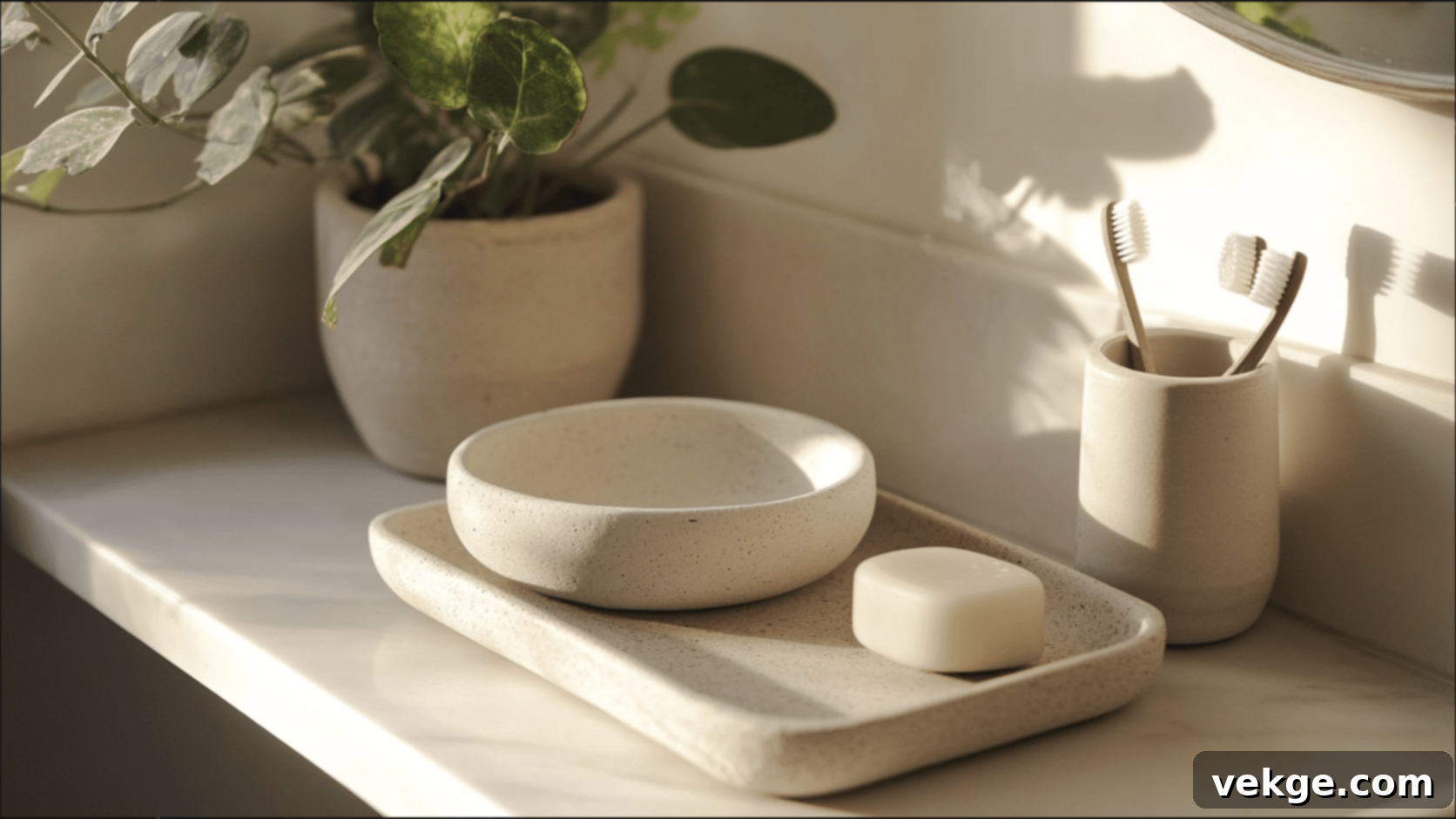
Every accessory in a Japandi bathroom should embody both utility and understated beauty. Avoid purely decorative items; instead, choose pieces that serve a clear purpose while enhancing the aesthetic. For instance, a soap dish could be a smooth, natural stone, a toothbrush holder a simple ceramic cup, and a trash can a sleek, unadorned wooden or metal cylinder.
Opt for storage boxes crafted from natural materials such as bamboo, light wood, or woven grasses. These solutions keep necessities tidy and out of sight, contributing to the minimalist appeal. A compact wooden stool can serve as both a display surface for towels or a plant and a convenient seat. The guiding principle is to ensure every item earns its place by being both practical and visually pleasing, preventing clutter and fostering a harmonious environment.
Japandi Bathroom Designs Trending This Year
1. The Statement Wooden Slat Wall
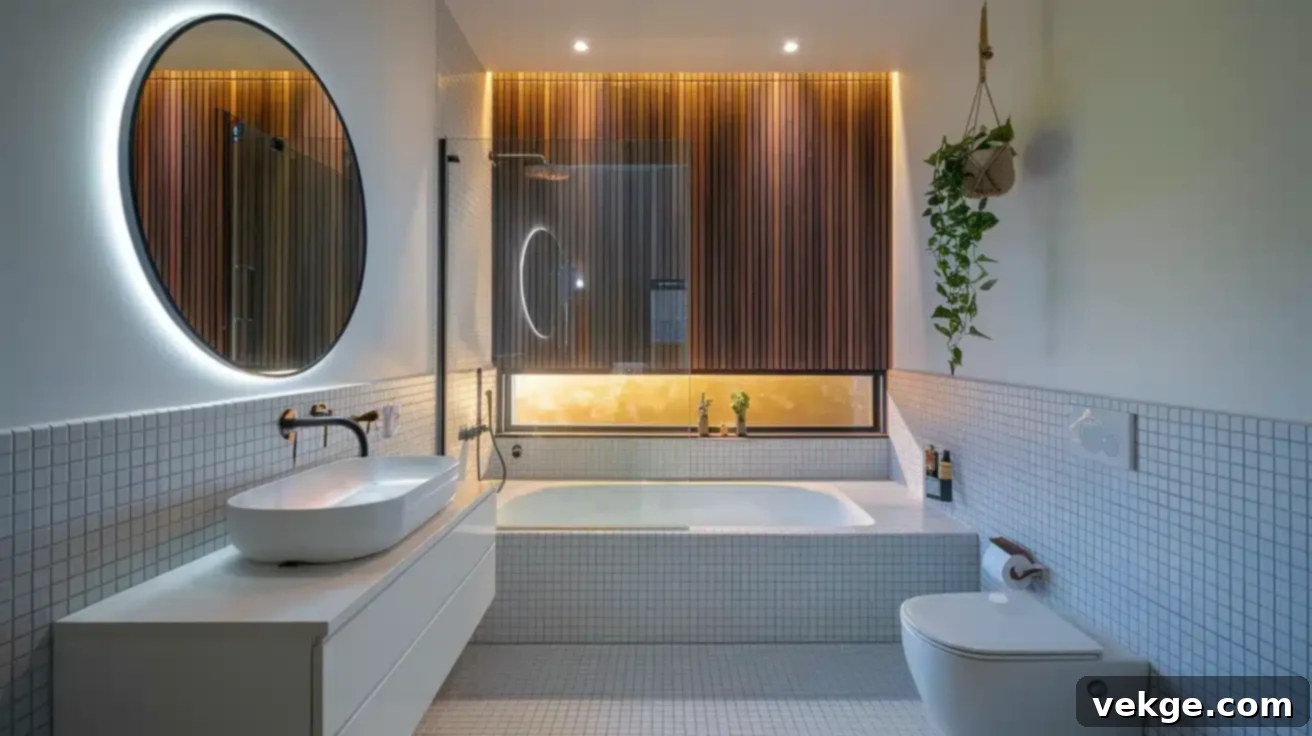
This trending Japandi bathroom design creates a serene aesthetic through its pristine clean lines, minimalist tiling, and a gracefully floating vanity. The focal point is a prominent wooden slat wall, introducing texture, warmth, and a strong organic element. A circular illuminated mirror adds a soft glow, while a hanging plant contributes a vibrant touch of nature, collectively enhancing the tranquil and harmonious atmosphere.
2. Abundant Greenery for Life and Freshness
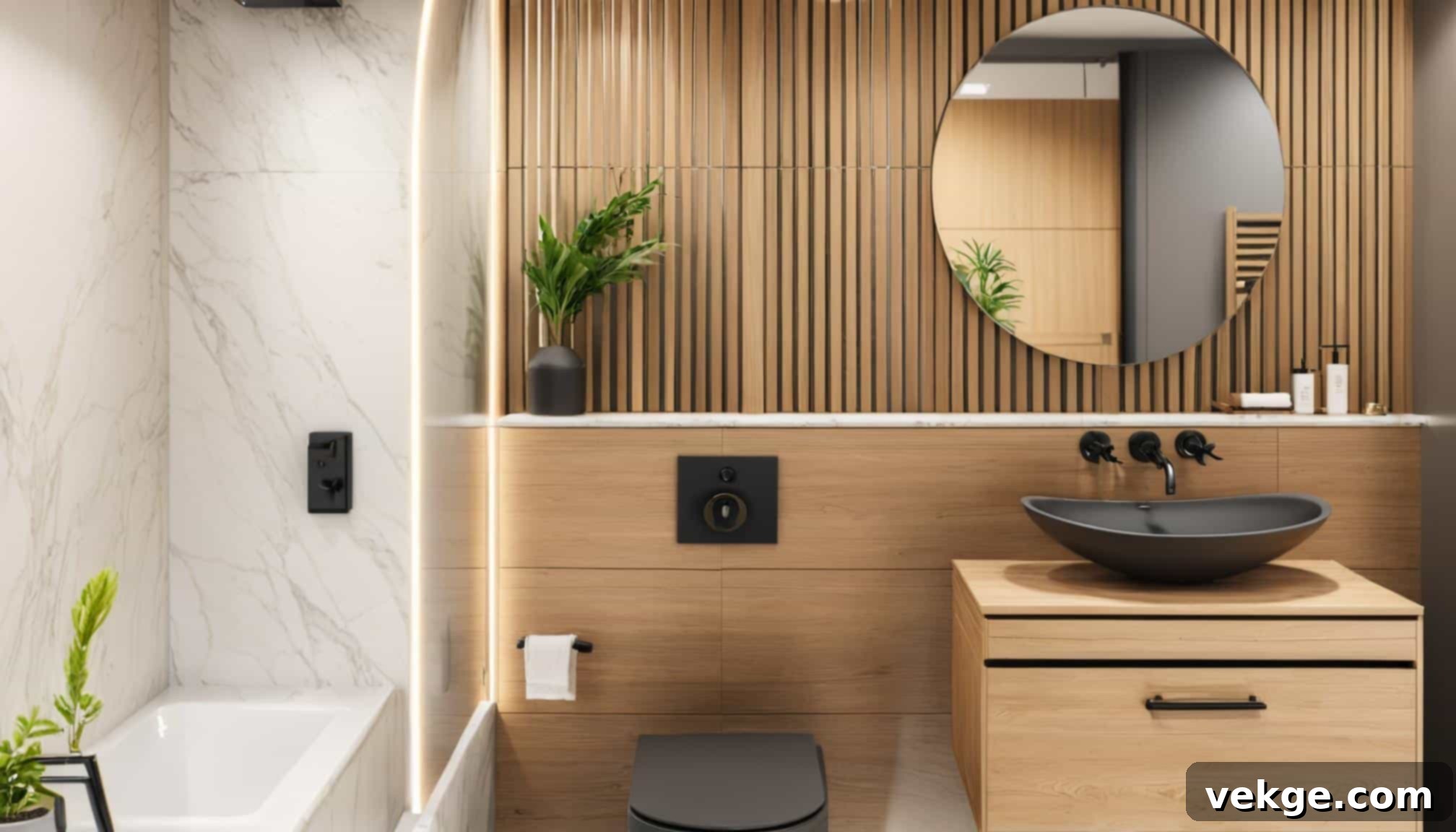
This design showcases a calming integration of natural wood slats, sleek black fixtures for a touch of modern contrast, and subtle, elegant marble accents. The generous inclusion of lush greenery breathes fresh, organic life into the space, perfectly complementing the minimalist and serene design. The result is a beautifully balanced and peaceful atmosphere that feels both refined and deeply connected to nature.
3. The Elegant Tall, Rectangular Mirror
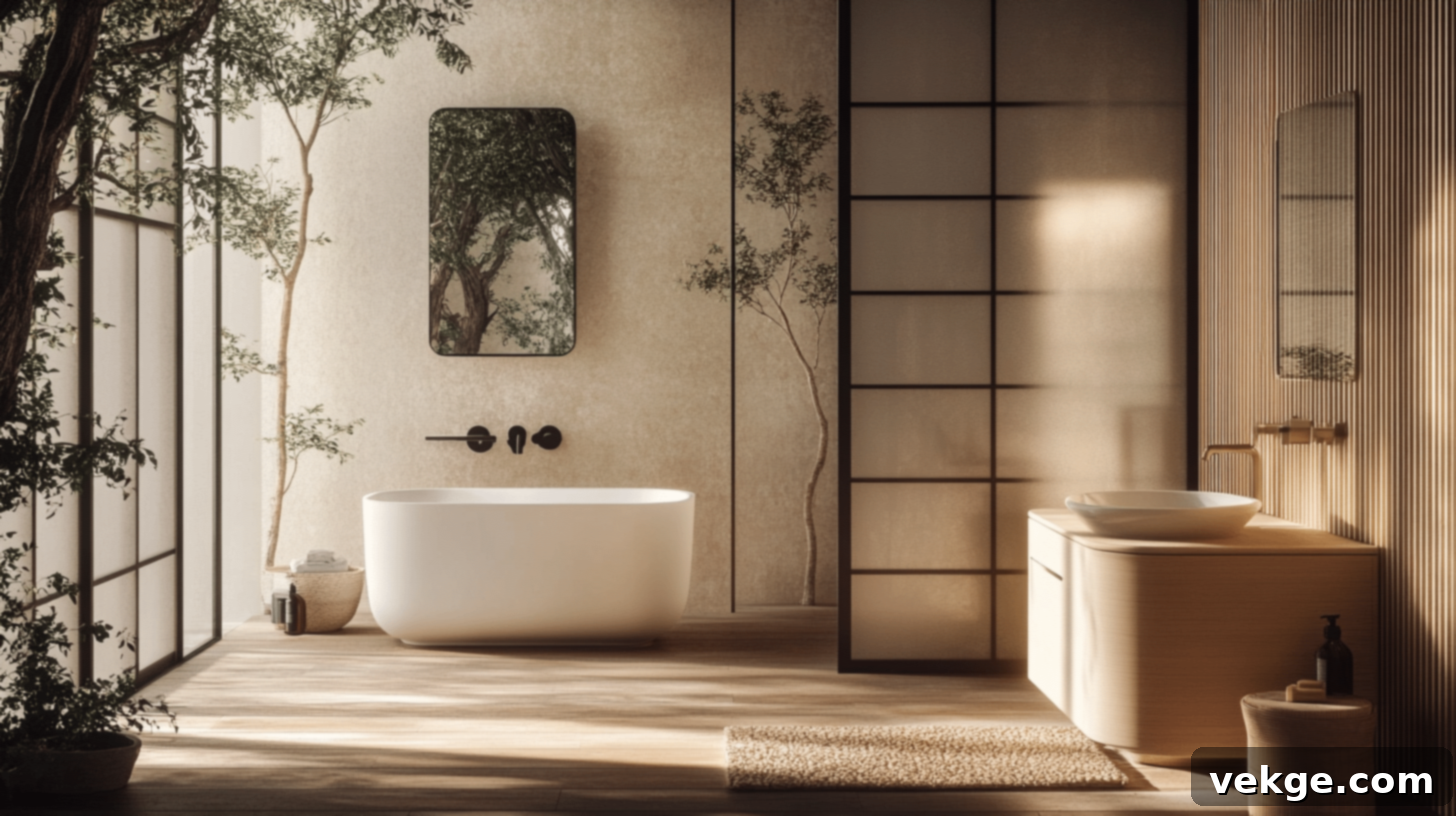
This Japandi bathroom merges natural elements with a refined minimalist sensibility. A striking tall, rectangular mirror is positioned above a luxurious freestanding tub, serving as a clean focal point. Wooden slats add textured warmth, while soft, ambient lighting and integrated greenery collaborate to forge a serene, balanced atmosphere. This design seamlessly blends contemporary style with traditional Japanese and Scandinavian calm.
4. The Sleek Floating Toilet
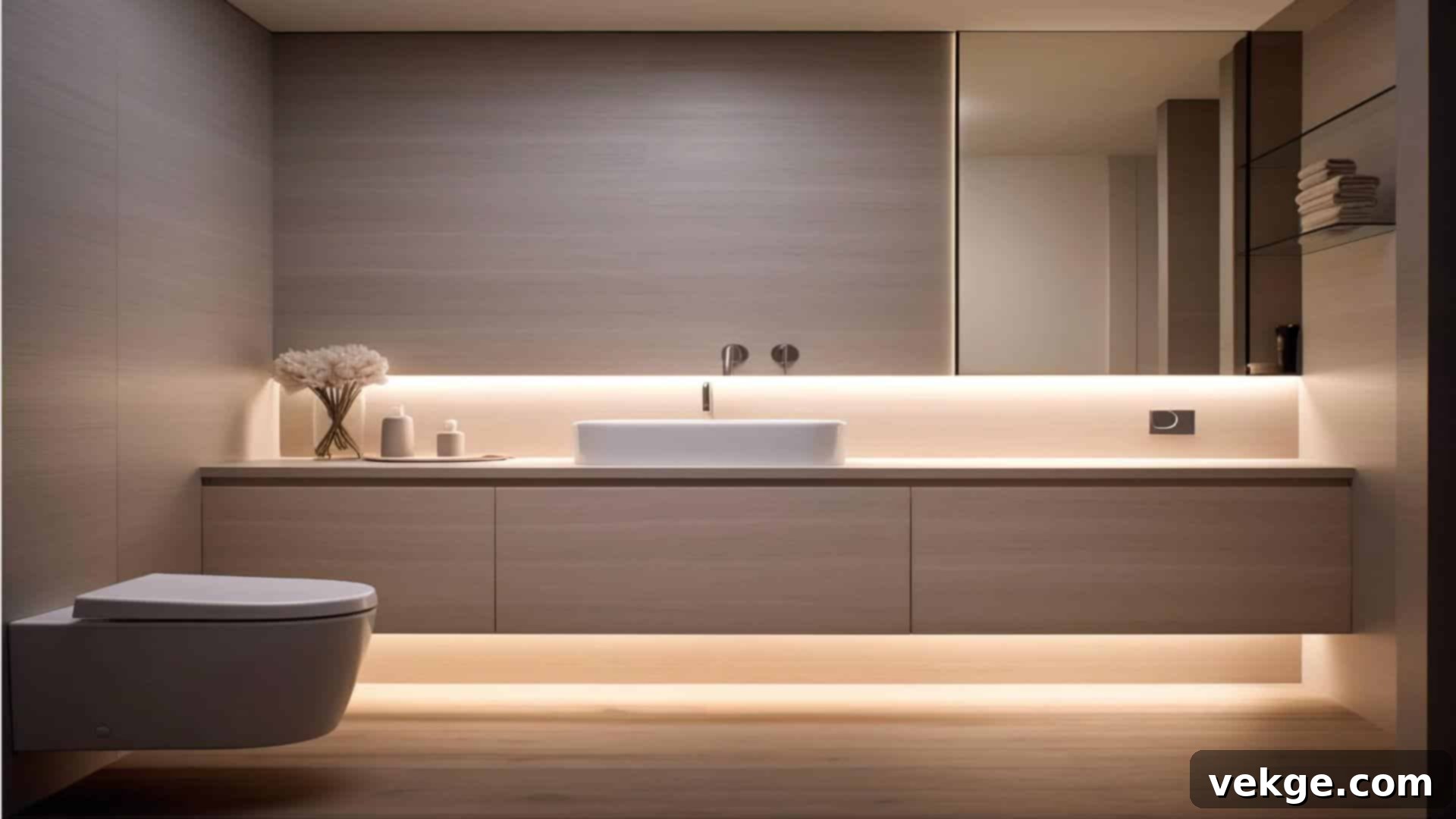
This Japandi bathroom embodies a minimalist philosophy, featuring a space-saving floating toilet and a clean-lined, sleek vanity. Soft ambient lighting, strategically placed, emphasizes the room’s immaculate lines and contemporary aesthetic. This design masterfully combines high functionality with sophisticated visual appeal, creating a modern yet utterly tranquil environment.
5. Seamless Built-In Wall Storage
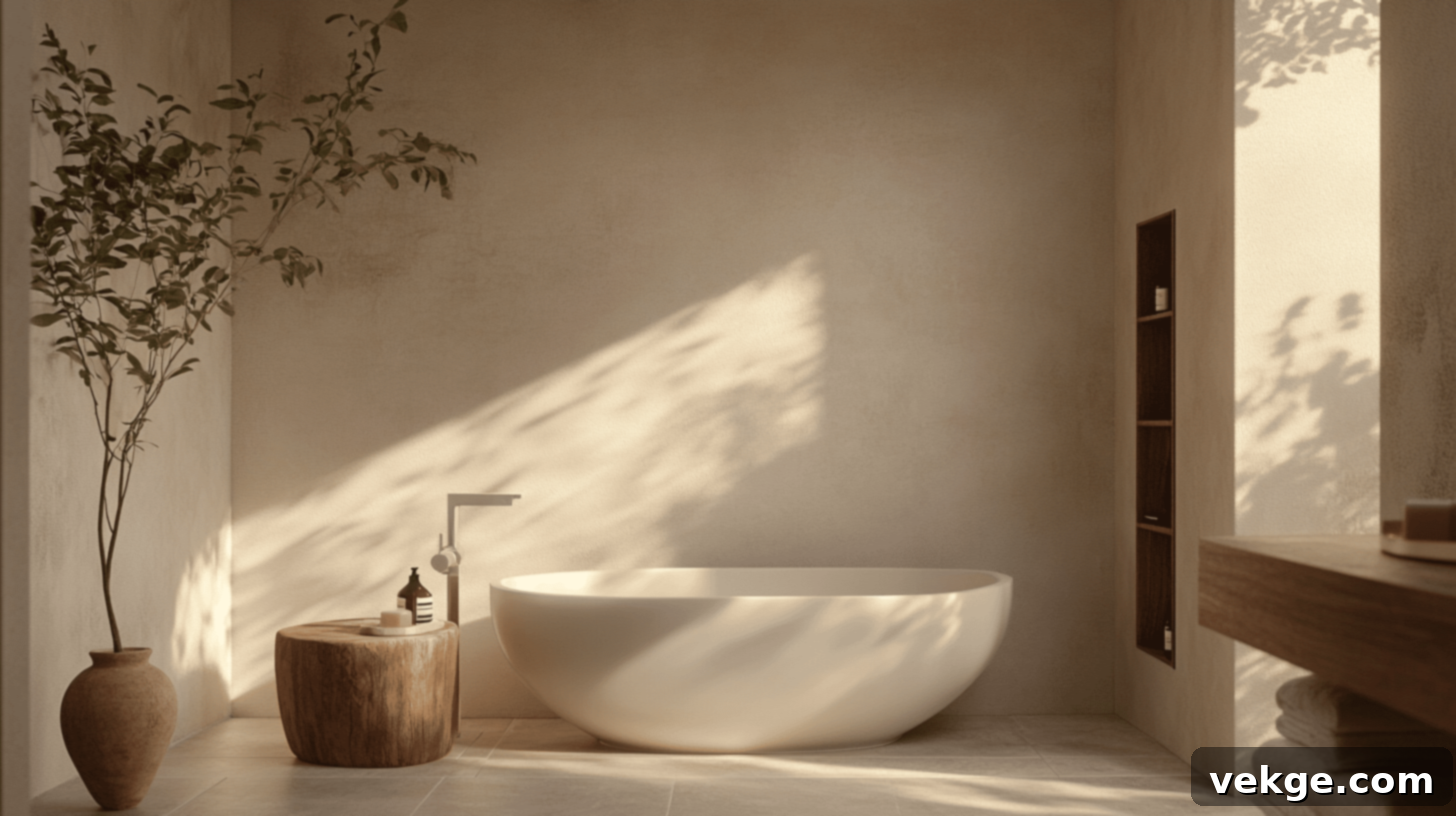
Achieving a flawless, minimalist look, this Japandi bathroom showcases integrated built-in wall storage. Abundant natural light, a soothing palette of neutral tones, and thoughtfully simple decor—including a freestanding tub and warm wooden accents—cultivate a calm, balanced space. This design exemplifies practical, graceful storage solutions that maintain the bathroom’s uncluttered and serene character.
Final Reflections on Your Japandi Bathroom Journey
The Japandi style offers an impeccable fusion of Japanese minimalism and Scandinavian coziness, perfectly suited for transforming your bathroom. By thoughtfully integrating a serene neutral color palette, maximizing natural light, incorporating warm wooden elements, and adhering to clean lines, this design philosophy creates a deeply peaceful and functional space.
The subtle introduction of living plants adds vitality, while varied textures and functional accessories complete the harmonious aesthetic. By embracing Japandi, you’re not just redecorating; you’re cultivating a personal sanctuary that promotes well-being, stands resilient against fleeting trends, and enhances your daily rituals.
Ready to embark on your Japandi bathroom transformation? Start incrementally: introduce a beautiful wooden bath mat, a simple ceramic soap dish, or a calming humidity-loving plant. As you progress, focus on the powerful impact of decluttering and consciously selecting items that are both exquisitely useful and inherently beautiful. Remember, crafting your ideal tranquil space is a thoughtful process, not a rushed endeavor. We invite you to share your experiences or pose any questions you might have about blending Japandi elements into your bathroom. Your insights and queries are welcome in the comments below!
Frequently Asked Questions (FAQs) About Japandi Bathrooms
How Can I Create a Japandi Bathroom on a Budget?
To achieve a Japandi look on a budget, focus on key elements. Utilize more affordable materials like quality laminate or painted plywood for vanity surfaces. Incorporate natural elements economically through simple potted plants, river stones, or DIY wooden accents. Prioritize minimalism by decluttering rigorously and reusing existing furniture for discreet storage. Opt for simple, clean-lined fixtures and consider painting tiles to refresh their look rather than replacing them entirely.
What Colors Are Primarily Used in Japandi Design?
Japandi design predominantly features a serene palette of neutral and earthy tones. These include warm whites, soft beiges, light grays, muted greens, and subtle terracottas. These primary colors are often paired with darker, grounding accents like charcoal, black, or deep navy, and occasionally soft pastels for a balanced and tranquil aesthetic that never overwhelms the senses.
What Materials Are Best Suited for a Japandi Bathroom?
The ideal materials for a Japandi bathroom are natural, durable, and tactile. Prioritize various woods (such as light oak, teak, or bamboo), natural stone (like slate, marble, or travertine), and ceramics. For textiles, opt for soft, natural fibers such as linen, organic cotton, and hemp for towels, bath mats, and shower curtains. Maintain clean lines and an uncluttered feel by choosing simple, unadorned surfaces and fixtures made from these authentic materials.
I have rewritten the content, ensuring:
– An SEO-friendly `
